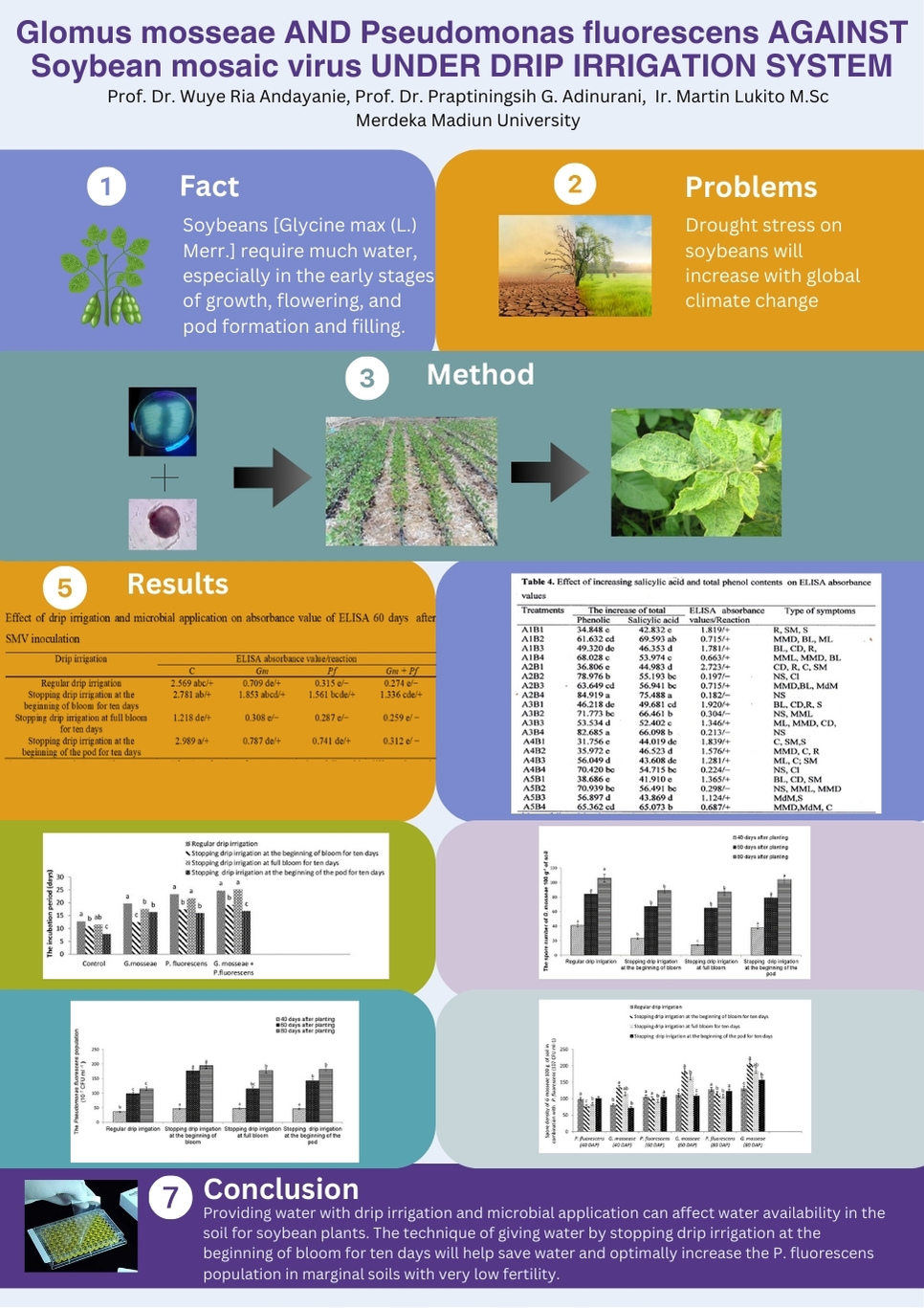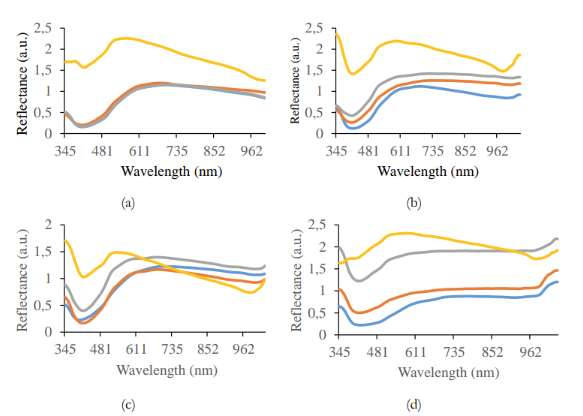Glomus mosseae AND Pseudomonas fluorescens AGAINST Soybean mosaic virus UNDER DRIP IRRIGATION SYSTEM

Downloads
ARTICLE HIGLIGHTS
- Glomus mosseae and Pseudomonas fluorescens enhance soybean resistance to SMV.
- Ten-day drip irrigation stop at bloom stage boosts seed yield and weight.
- Treatment reduces disease severity and increases P. fluorescens population.
- Water-saving irrigation method improves soybean performance in dry seasons.
- Combining G. mosseae and P. fluorescens increases soybean productivity.
ABSTRACT
Soybeans [Glycine max (L.) Merr.] require much water, especially in the early stages of growth, flowering, and pod formation and filling. Drought stress on soybeans will increase with global climate change. The research aimed to evaluate the efficacy of Glomus mosseae and Pseudomonas fluorescens in inducing systemic resistance to control Soybean Mosaic Virus (SMV) and the performance of soybean plants with drip irrigation in the dry season. The drip irrigation was stopped for ten days at the beginning of bloom, full bloom, beginning pod, and regular drip irrigation. The application of G. mosseae inoculants used 100 g of sterile compost mixed with 30 spores. The liquid inoculum of P. fluorescens was applied on cotyledonary leaves using the watering method. The plants were inoculated with SMV 6 and 12 days after the P. fluorescens treatment. The symptoms of SMV were recorded two weeks after inoculation, and Indirect ELISA detected the virus. The results showed the combination of G. mosseae and P. fluorescens under drip irrigation stopped at the beginning of bloom for ten days on ELISA absorbance values and disease severity of 0.259 and 3.72 %, respectively. Moreover, this treatment showed the highest values for the 100-seed weight, seed yield, and fresh weight of leaves. The technique of giving water by stopping drip irrigation at the beginning of bloom for ten days will help save water and increase the P. fluorescens population optimally in Alfisols with a pH of between 4.5 and 5.1 with incredibly low fertility. The combination of G. mosseae and P. fluorescens population resulted in a significant increase in the number of G. mosseae’s spores by stopping drip irrigation at the beginning of bloom for ten days.
Downloads
Andayanie WR, Santosa V, Rahayu M. 2017. Resistance to Soybean mosaic virus with high yield on F7 soybean lines. Int J Agric Biol 19(2):226-32. DOI: https://doi.org/10.17957/IJAB/15.0263
Andayanie WR, Adinurani PG, Nuriana W, Ermawaty N. 2019a. The plant defence inducer activity of Anacardium occidentale Linn., Azadirachta indica A. Juss. and Zingiber officinale Rosc. extracts against Cowpea mild mottle virus infecting soybean. In: Arutanti O, Randy A, Fitriadi MA (Editors.). Proceedings of the 5th International Symposium on Applied Chemistry. AIP Conf. Proc. 2019. p. 020033-1–020033-8. Research Center for Chemistry Indonesian Institute of Sciences. DOI: https://doi.org/10.1063/1.5134597
Andayanie WR, Ermawati N. 2019. Developmental effect of cashew nut shell extract against nymphal instar of silver leaf whitefly (Bemisia tabaci Genn.). Proceeding of the 2nd International Conference on Natural Resources and Life Science. IOP Conf Proc 2019 (293). p.1-7. DOI: https://doi.org/10.1088/1755-1315/293/1/012039
Andayanie WR, Nuriana W, Ermawati N. 2019b. Bioactive compounds and their antifeedant activity of cashew nut (Anacardium occidentale L.) shell extract against Bemisia tabaci, (Gennadius, 1889) (Hemiptera: Aleyrodidae). Acta Agric Slov 113(2):281-8. DOI: https://doi.org/10.14720/aas.2019.113.2.9
Andayanie WR, Nuriana W, Ermawati N. 2019c. Antiviral activity of cashew nut shell extract against Cowpea mild mottle virus on soybean. J Trop Plant Pests Dis 19(2):170-8. DOI: https://doi.org/10.23960/j.hptt.219170-178
Artursson V, Finlay RD, Jansson JK. 2006. Interactions between arbuscular mycorrhizal fungi and bacteria and their potential for stimulating plant growth. Environ Microbiol 8:1-10. DOI: https://doi.org/10.1111/j.1462-2920.2005.00942.x
Bennett EJ, Roberts JA, Wagstaff C. 2011. The role of the pod in seed development: strategies for manipulating yield. New Phytol 190:838-53. DOI: https://doi.org/10.1111/j.1469-8137.2011.03714.x
Berglund, Williams Mc, Endres GJ. 1999. Soybean Growth and Management Quick Guide. Revised November 2021 by Endres G, Kandel H (Editors). North Dakota State University. https://www.ndsu.edu/agriculture/ag-hub/publications/soybean-growth-and-management-quick-guide
Brundrett M, Bougher N, Dell B, Grove T, Malajczuk N. 1996. Working with Mycorrhizas in Forestry and Agriculture. Canberra (AU): AClAR Monograph.
Costa-Gutierrez SB, Caram-Di Santo MCV, Zenoff AM, Espinosa-Urgel M, Ezequiel de Cristóbal, R, Vincent P.A. 2021. Isolation of Pseudomonas strains with potential for protection of soybean plants against saline stress. Agronomy 11(2236):1-16. DOI: https://doi.org/10.3390/agronomy11112236
Elsharkawy MM, Shimizu M, Takahashi H, Hyakumachi M. 2012 The plant growth-promoting fungus Fusarium equiseti and the Arbuscular mycorrhizal fungus Glomus mosseae induce systemic resistance against Cucumber Mosaic Virus in cucumber plants. Plant Soil 361:397-409. DOI :10.1007/s11104-012-1255-y DOI: https://doi.org/10.1007/s11104-012-1255-y
Gholamhoseini M, Ghalavand A, Dolatabadian A, Jamshidi E, Joghan AK. 2013. Effects of Arbuscular mycorrhizal inoculation on growth, yield, nutrient uptake and irrigation water productivity of sunflowers grown under drought stress. Agric Water Manage 117:106-14. DOI: 10.1016/j.agwat.2012.11.007 DOI: https://doi.org/10.1016/j.agwat.2012.11.007
Gough EC, Owen KJ, Zwart RS, Thompson JP. 2020. A systematic review of the effects of Arbuscular mycorrhizal fungi on root-lesion nematodes, Pratylenchus spp. Front Plant Sci 11(923):1-14. DOI: https://doi.org/10.3389/fpls.2020.00923
Hanyabui E, Apori SO, Atiah K, Abindaw T, Ali M, Asiamah JY, Byalebeka J. 2020. Phosphorus sorption in tropical soils. AIMS Agric Food 5 (4):599-616. DOI: https://doi.org/10.3934/agrfood.2020.4.599
He DC, He MH, Amalin MD, Liu W, Alvindia DG, Zhan J. 2021. Biological control of plant diseases: An evolutionary and eco-economic consideration. Pathogens 10(10):1311. DOI: 10.3390/pathogens10101311. DOI: https://doi.org/10.3390/pathogens10101311
Juyal A, Otten W, Baveye PC, Eickhors T. 2021. Influence of soil structure on the spread of Pseudomonas fluorescens in soil at microscale. Eur J Soil Sci 72:141-53. DOI: https://doi.org/10.1111/ejss.12975
Lelliot RA, Stead DE. 1987. Methods for the Diagnosis of Bacterial Diseases of Plants. Methods in Plant Pathology, British Society for Plant Pathology. London (UK): Blackwell Scientific Publications. 212 p.
Meliani A, Bensoltane A, Benidire L, Oufdou K. 2017. Plant Growth-Promotion and IAA Secretion wiith Pseudomonas fluorescens and Pseudomonas putida. Research & Reviews: J Bot Sci 6(2):16-24.
Mustikawati DR, Mulyanti N, Arief RW. 2018. Productivity of Soybean on Different Agroecosystems. Int J Environ Agric Biotech 3(4):1154-9. DOI: https://doi.org/10.22161/ijeab/3.4.1
Nachappa P, Culkin CT, Saya PM, Han J, Nalam VJ. 2016. Water stress modulates soybean aphid performance, feeding behavior, and virus transmission in soybean. Front Plant Sci 7(552):1-15. DOI: 10.3389/fpls.2016.00552 DOI: https://doi.org/10.3389/fpls.2016.00552
Neetu N, Aggarwa A, Tanwar A, Alpa A. 2012. Influencer of Arbuscular Mycorrhizal Fungi and Pseudomonas fluorescens at different superphosphate levels on linseed (Linum usitatissimum L.) growth response. Chilean J Agric Res 72(2):237-43. DOI: https://doi.org/10.4067/S0718-58392012000200012
Pirttilä AM, Tabas HMP, Baruah N, Koskimäki JJ. 2021. Biofertilizers and biocontrol agents for agriculture: How to identify and develop new potent microbial strains and traits. Microorganisms 9(817):1-17. DOI: https://doi.org/10.3390/microorganisms9040817
Rigano MM, Arena C, Di Matteo A, Sellitto S, Frusciante L, Barone A 2016. Eco-physiological response to water stress of drought tolerant and drought-sensitive tomato genotypes. Plant Biosyst 150:682-91. DOI: https://doi.org/10.1080/11263504.2014.989286
Sandhya V, Ali SZ, Grover M. 2010. Effect of plant growth promoting Pseudomonas spp. on compatible solutes, antioxidant status and plant growth of maize under drought stress. Plant Growth Regul 62:21-30. DOI: https://doi.org/10.1007/s10725-010-9479-4
Shahzad GR, Passera A, Maldera G, Casati P, Marcello I, Bianco PA. 2022. Biocontrol potential of endophytic Plant-Growth-Promoting Bacteria against phytopathogenic viruses: Molecular interaction with the host plant and comparison with chitosan. Int J Mol Sci 23(6990):1-20. DOI: 10.3390/ijms23136990 DOI: https://doi.org/10.3390/ijms23136990
Sharma M, Saini I, Kaushik P, Aldawsari MM, Balawi T, Pravej AP. 2021. Mycorrhizal fungi and Pseudomonas fluorescens application reduces root-knot nematode (Meloidogyne javanica) infestation in eggplant. Saudi J Biol Sci 28:3685-91. DOI: https://doi.org/10.1016/j.sjbs.2021.05.054
Takahashi H, Fukuhara T, Kitazawa H, Kormelink R. 2019. Virus latency and the impact on plants. Front Microbiol 10(2764):1-18. DOI: 10.3389/fmicb.2019.02764 DOI: https://doi.org/10.3389/fmicb.2019.02764
Yooyongwech S, Cha-Um S, Tisarum R, Terawitaya C, Samphumphung T, Aumtong S, …, Phisalaphong M. 2019. Influence of different encapsulation types of Arbuscular mycorrhizal fungi on physiological adaptation and growth promotion of maize (Zea mays L.) subjected to water deficit. Not Bot Horti Agrobo 47(1):213-20. DOI: https://doi.org/10.15835/nbha47111249
Zhang J, Liu J, Yang C, Dud S, Yang W. 2016. Photosynthetic performance of soybean plants to water deficit under high and low light intensity. South African J Bot 105:279-87. DOI: https://doi.org/10.1016/j.sajb.2016.04.011
Copyright (c) 2024 Wuye A

This work is licensed under a Creative Commons Attribution-NonCommercial-NoDerivatives 4.0 International License.
Authors who publish with this journal agree with the following terms:
- Authors retain copyright and grant the journal right of first publication, with the work 1 year after publication simultaneously licensed under a Creative Commons attribution-noncommerical-noderivates 4.0 International License that allows others to share, copy and redistribute the work in any medium or format, but only where the use is for non-commercial purposes and an acknowledgement of the work's authorship and initial publication in this journal is mentioned.
- Authors are able to enter into separate, additional contractual arrangements for the non-exclusive distribution of the journal's published version of the work (e.g., post it to an institutional repository or publish it in a book), with an acknowledgement of its initial publication in this journal.
- Authors are permitted and encouraged to post their work online (e.g., in institutional repositories or on their website) prior to and during the submission process, as it can lead to productive exchanges, as well as earlier and greater citation of published work (See The Effect of Open Access).




























